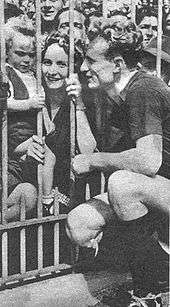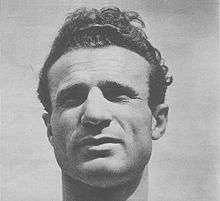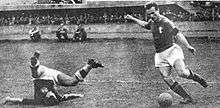Valentino Mazzola
|
Valentino Mazzola with Torino | |||
| Personal information | |||
|---|---|---|---|
| Date of birth | 26 January 1919[1] | ||
| Place of birth | Cassano d'Adda, Italy | ||
| Date of death | 4 May 1949 (aged 30) | ||
| Place of death | Superga, Italy | ||
| Height | 1.70 m (5 ft 7 in) | ||
| Playing position |
Attacking Midfielder Forward | ||
| Youth career | |||
| 1934–193? | Tresoldi | ||
| 193? | Fara d'Adda | ||
| 193?–1936 | Tresoldi | ||
| Senior career* | |||
| Years | Team | Apps | (Gls) |
| 1936–1938 | Tresoldi | ||
| 1938–1939 | Alfa Romeo | (?) | (18) |
| 1939–1942 | Venezia | 61 | (12) |
| 1942–1949 | Torino | 195 | (118) |
| Total | 256+ | (148) | |
| National team | |||
| 1942–1949 | Italy | 12 | (4) |
|
* Senior club appearances and goals counted for the domestic league only. | |||
Valentino Mazzola (Italian pronunciation: [valenˈtiːno matˈtsɔːla]; 26 January 1919 – 4 May 1949) was an Italian footballer who played as an attacking midfielder or forward.
Considered one of the great number 10s in the history of football[2] and, according to some, the best Italian footballer of all time,[3][4] Mazzola was the captain and symbol of the "Grande Torino", the team recognised as one of the strongest in the world during the second half of the 1940s,[5] with whom Mazzola won five Serie A championships. He was also captain of the Italian national team for a biennium.[6]
He became known during his spell at Venezia, where he played as a midfielder, a playing position he held throughout his career that allowed him to expand his fame beyond Italy. In his later seasons, he was considered one of the best players in Europe in his role.[7] He died at the age of 30 in the Superga air disaster.[6][8]
Early life

He was born in Cassano d'Adda, Ricetto, a neighbourhood of abandoned homes to a very modest family. His father, Alessandro, was a labourer for Azienda Torinese Mobilità and died in August 1940, hit by a truck. His mother's name was Leonina Ratti and his four brothers were Piero, Silvio, Carlo and Stefano. He had an unsettled childhood; in 1929 his father was fired from his job because of the Great Depression. To help his family, Valentino sought work the following year, just as he finished the first year of grade school. He found employment as a baker's boy, then, at age 14, the linen mill at Cassano d'Adda.[2][9]
In the summer of 1929, at age 10, he threw himself into the river Adda to save the life of a boy four years his junior from drowning: his name was Andrea Bonomi, the future football player and captain of A.C. Milan. A Juventus fan at a young age, he was nicknamed "Tulen" for his habit of kicking old tin cans: which Valentino would kick on his journey between home and the linen mill. He played in his local neighbourhood team, the "Tresoldi" and was noticed by a football fan who worked as a test driver for the Alfa Romeo factory in Arese, who offered Valentino a place in the Alfa Romeo team and a job as a mechanic.[6]
In 1939 he was called up to join military service in the Royal Navy, in the port of Venice; he spent a few months on the ship, aboard the destroyer Confienza, and was later moved to the Compagnia del Porto. In Venice he obtained his elementary school diploma, attending night school.[6]
Valentino was a private person of few words. On 15 March 1942 he married Emilia Rinaldi, whom he had two sons, both players: Sandro - who played for Inter Milan and the Italian national team - and Ferruccio (who was named in honour of the president of Torino, Ferruccio Novo), born respectively in 1942 and 1945. In Turin he lived in a small apartment in Via Torricelli 66. He worked in Lingotto and reported as a FIAT worker essential to wartime production, to avoid participating directly in the Second World War. Although the Torino players salaries were very good, they were not considered exaggerated, compared to normal payroll. The players were not considered professionals and officially held other jobs; in the aftermath of the war, Mazzola owned a sports shop in Turin, where he sold footballs that he manufactured personally.[6]
Mazzola, who considered himself a solitary person led a secluded life, prioritised football above all. His entertainment consisted of a few games of bowls near his house. He used to write down everything, both in regard to his personal and professional life. He was very strict and meticulous and demanded the same treatment from others; this was the main reason for separation from his first wife, who was no longer willing live with his firm discipline. He separated from his wife in autumn 1946 and remarried on 20 April 1949 to the 19-year-old Giuseppina Cutrone. On 4 May 1949, just days after his second marriage, he died in the Superga air disaster, unfortunately, as he thought he would die because of war or misfortune; a sign of fate, given his fear of flying.[6]
Club career
Early career
Although he started working at a young age, Mazzola continued to cultivate his passion for football; was a leader of Tresoldi, of the team Cassano d'Adda, who observed him play in the fields and introduced him to the youth team in 1934. He briefly moved to Fara d'Adda and then returned to Tresoldi. He was used in the roles of centre midfielder and right midfielder, even though he was already a multi-purpose player. He participated in his first season with Tresoldi in 1935–36 and the following year he entered into the first team, earning 10 lire per game.[6]
In 1938, the same period when Alfa Romeo made him a work proposal that included the possibility of playing in Serie C, he received an offer by A.C. Milan, the first real offer of his career, with the prospect to play in Serie A. He was very indecisive and opted for Alfa Romeo, because the car manufacturer also guaranteed him a job.[6]
At Alfa Romeo he played one season as a winger; but according to another source, he instead played as a right midfielder. He left the team in 1939, after having played in front of an audience, who appreciated his rhythm and play, to join the military service in Venice.[6]

Venezia
In 1939, while he was performing his military service in the Navy, he took part in several matches in the team of the Navy, played on the field of basins, putting on a good display, despite weighing 90 kg. He was noted by some observers of Venezia, who after various stresses succeeded in getting him to audition; according to another source, a naval officer who was a fan of Venezia, admired the skill of Valentino and offered him to the Lagunari. At the trial, which he showed up and played barefoot, having left his boots intentionally at home not to ruin them, he convinced everyone, especially the manager Giuseppe Girani to purchase him. After a few months in the reserve team, which participated in its own championship, he was hired on 1 January 1940 for 50,000 lire. He made his debut in Serie A on 31 March 1940 in the match Lazio – Venezia (1–0), taking the place of the center forward Francesco Pernigo, unavailable, and kept his place in the starting lineup on his own merits. He played in all five of the remaining league games, often in the middle of the attack, creating a goal on the penultimate day against Bari - which was the final goal in a 2–1 win for Venezia and guaranteed them mathematical safety of staying in Serie A - and a match in Coppa Italia, namely the round of 16 match against Modena – Venezia (3–1), the only goal his team scored.[6]
It was during this time at Venezia that Mazzola first met Ezio Loik, when the latter moved to the club from Milan. A nine-year partnership in both triumph and tragedy began. They debuted together in the 1942 game Italy played against Croatia and won 4–0. Both were very different, although they came from very humble backgrounds: Fiume-born Loik was quiet and somewhat defensive, while Lombard Mazzola was much more impulsive and friendly. Loik did not like Valentino at first instance, taking his reserve for arrogance, but both soon found a way of understanding each other. The partnership of both half-wings (mezzala in Italian) was based on the Fiuman's stubborn generosity and the Milanese's rare talent. Soon, they became Italy's most coveted uprising young players. Ironically, for a man later to die in an accident himself, at the age of ten, Mazzola saved the life of Andrea Bonomi, later a defender for A.C. Milan, by rescuing him from a river.[6]
Mazzola's career with Venezia started modestly, with a tenth-placed finish in 1940 and a twelfth-place finish the next season. In 1941, however, the team won the Coppa Italia Final against Roma and finished third in the league in 1942.[6]
Torino
As they finished third in the league, Venezia were only a single point behind Torino, who promptly began to take notice of Mazzola. The only problem was that Juventus had a verbal agreement with Venezia that they would sign Mazzola. However, Torino eventually offered 200,000 lira plus two players and won the player's signature.[6]
Although the deal was intended to be kept secret, news of the upcoming move got out and as Venezia played Torino, the crowd began to taunt Mazzola, calling him a "sell-out". The outraged Mazzola clenched his fists and promptly led Venezia to a 3–1 win.[6]
With Torino, Mazzola won the wartime league title in 1943. In 1944, the championship ended early, but Mazzola managed to score 10 goals (in context, however, Silvio Piola scored 31).[6]
In 1946, Mazzola helped the team to the title, which they won over Inter Milan by 13 points. The next season, Torino won the title again, beating second-placed Juventus by 10 points. In 1948, Torino broke numerous records, including ending the season with the biggest ever advantage over the second-placed team (they beat Milan to the title by 16 points) and on 11 May 1947, Torino provided 10 of the 11 players who took to the field against Hungary. Mazzola played 12 matches with the Italian national team and scored 4 goals, also serving as the side's captain between 1947 and 1949.[6]
In the 1948–49 season, Torino won the last title they would get until 1976. Mazzola scored 109 goals in the Italian Championship with Venezia and Torino over 8 years.[6]
International career
Mazzola then made his debut for the national side on 5 April 1942, when he scored a goal.[6]
Death
Despite suffering from illness, Mazzola was determined to attend the match he had organised for Torino in Lisbon in 1949. On 4 May, on the return journey from the game, the aircraft carrying Mazzola and the rest of the team crashed, killing everyone on board and leaving only one first-team player at Torino alive.[10]
Style of play

Valentino Mazzola is considered one of the best football players of all time, and perhaps the first modern all-around footballer, as he was a well-rounded, versatile, and hardworking footballer who could lead his teammates to victory with his charismatic presence and leadership (Mazzola was famous for raising his shirt's sleeves when his team was not playing well as a signal to his teammates and the fans).[11] Mazzola was a quick, strong and energetic attacking midfielder, with excellent technical ability, dribbling skills, vision, and accurate shooting and passing ability; he was also capable of playing as a forward and excelled in the air, despite his small stature, due to his elevation, which allowed him to beat larger players for the ball. Because of his many attributes he was capable of both scoring and creating many goals, and was also competent defensively, often pressing and tackling opponents in order to win back possession.[6]

Quotes
By Mazzola
- “You can always win in football, as long as you change.”
- “Football will always be a game of eleven."
On Mazzola
- “He alone is half the squad. The other half is made by the rest of us together.” (team-mate Mario Rigamonti).[11]
Trivia
- José Altafini, a forward who won the 1958 World Cup with Brazil and also played for Italy, Palmeiras, and A.C. Milan is called "Mazzola" in his home country, because when he started to play, it was said he looked like the great Valentino.[12]
- In the Milan area, players who insist on dribbling rather than passing are called "Veneziani" (Venetians). This is a reference to Valentino Mazzola when he played for Venezia.[13]
Honours
Club
- Coppa Italia (1): 1940–41
Individual
- Seria A top goal scorer (1): 1946–47[6]
- Coppa Italia top goalscorer (1): 1942–43[6]
- Inducted into the Italian Football Hall of Fame (Posthumously): 2012[6]
- Italy's Sports Walk of Fame: 2015.[14][15]
References
- ↑ Enciclopedia Del Calcio
- 1 2 Sappino. pp. 347, 348.
- ↑ Foot. pp. 159, 160.
- ↑ Massimo Filipponi (2 January 2000). "Nessuno è stato superiore al Grande Torino" (PDF) (in Italian). L'Unità. p. 20. Retrieved 9 December 2011.
- ↑ Sconcerti. p. 75.
- 1 2 3 4 5 6 7 8 9 10 11 12 13 14 15 16 17 18 19 20 21 22 23 24 "VALENTINO MAZZOLA" (in Italian). Storie di Calcio. Retrieved 29 December 2014.
- ↑ Paolo Spriano (5 May 1949). "La terribile sciagura di Superga" (PDF) (in Italian). L'Unità (ed. piemontese). p. 3. Retrieved 9 December 2011.
- ↑ "The heartbeat of Il Grande Torino: Valentino Mazzola". FIFA. Retrieved 30 May 2015.
- ↑ "La prima moglie di Mazzola ritrova il figlio nei pressi di Casale" (in Italian). Nuova Stampa Sera. 10 May 1949. p. 2. Retrieved 11 February 2012.
- ↑ Amlan Majumdar (29 October 2011). "'The Heir Did Arrive' – The Story Of Valentino And Sandro Mazzola". The Hard Tackle. Retrieved 30 May 2015.
- 1 2 Ed Valentine (9 November 2014). "Valentino Mazzola, at the heart of the legendary Torino team". World Soccer. Retrieved 30 May 2015.
- ↑ "José Joao ALTAFINI ("Mazola")" (in Italian). magliarossonera.it. Retrieved 28 December 2014.
- ↑ Alessandro Zanaboni. "Il calciatore "veneziano"" (in Italian). Il Corriere della Sera. Retrieved 31 May 2015.
- ↑ "Inaugurata la Walk of Fame: 100 targhe per celebrare le leggende dello sport italiano" (in Italian). Coni. 7 May 2015. Retrieved 26 August 2015.
- ↑ "CNA 100 Leggende CONI per data di nascita" (PDF) (in Italian). Coni. Retrieved 23 September 2015.
External links
| Sporting positions | ||
|---|---|---|
| Preceded by Silvio Piola |
Italy captain 1947–1949 |
Succeeded by Riccardo Carapellese |
